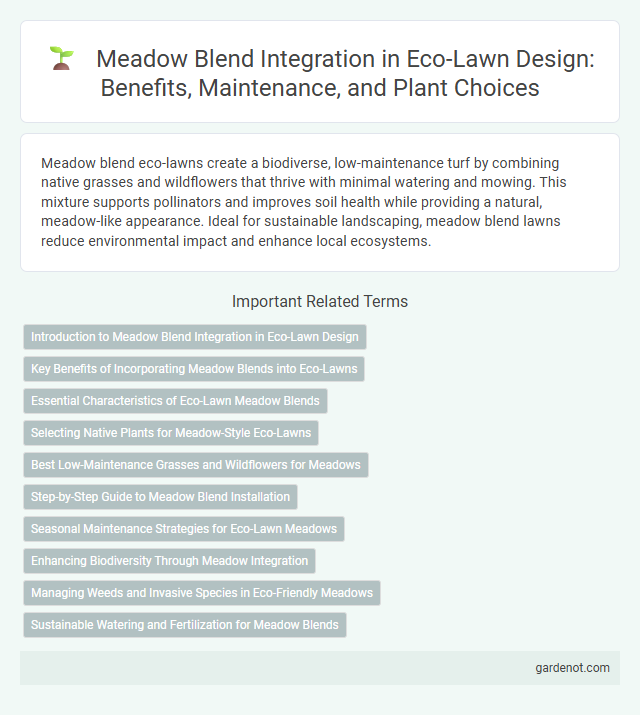Meadow blend eco-lawns create a biodiverse, low-maintenance turf by combining native grasses and wildflowers that thrive with minimal watering and mowing. This mixture supports pollinators and improves soil health while providing a natural, meadow-like appearance. Ideal for sustainable landscaping, meadow blend lawns reduce environmental impact and enhance local ecosystems.
Introduction to Meadow Blend Integration in Eco-Lawn Design
Meadow blend combines native wildflowers and grasses, enhancing biodiversity and promoting pollinator habitats within eco-lawn designs. Incorporating meadow blends reduces maintenance needs by minimizing mowing and irrigation while supporting soil health. Integrating diverse plant species in eco-lawns creates resilient landscapes that tolerate varying environmental conditions and contribute to sustainable urban green spaces.
Key Benefits of Incorporating Meadow Blends into Eco-Lawns
Meadow blends in eco-lawns enhance biodiversity by supporting pollinators and native wildlife, contributing to a healthier ecosystem. These blends improve soil health and water retention, reducing the need for irrigation and chemical inputs while promoting natural resilience. Incorporating meadow blends also offers aesthetic diversity with seasonal blooms, creating a vibrant, low-maintenance landscape that conserves resources.
Essential Characteristics of Eco-Lawn Meadow Blends
Eco-lawn meadow blends feature drought-resistant native grasses and wildflowers that create a low-maintenance, sustainable lawn alternative. These blends support biodiversity by attracting pollinators and provide seasonal color variation with a mix of flowering species. Their deep root systems improve soil health and water retention, reducing irrigation needs and promoting ecological balance.
Selecting Native Plants for Meadow-Style Eco-Lawns
Meadow blend eco-lawns thrive by selecting native plants well-adapted to local soil and climate conditions, supporting biodiversity and reducing maintenance needs. Choosing native wildflowers and grasses like little bluestem, black-eyed Susan, and purple coneflower promotes pollinator habitats and improves soil health naturally. This approach enhances ecosystem resilience, providing a sustainable, low-water alternative to traditional lawns.
Best Low-Maintenance Grasses and Wildflowers for Meadows
Meadow blend seeds combine drought-tolerant grasses such as fescue and blue grama with native wildflowers like black-eyed Susan and coneflower, creating a sustainable, low-maintenance lawn alternative. These species thrive in poor soils and require minimal watering and mowing, promoting biodiversity and reducing environmental impact. Ideal for eco-conscious landscaping, meadow blends support pollinators while providing natural beauty with seasonal color variations.
Step-by-Step Guide to Meadow Blend Installation
Prepare the soil by removing existing grass and weeds, then tilling the ground to create a smooth seedbed for the meadow blend. Evenly distribute the seed mix, ensuring a balanced spread of native wildflowers and grasses, followed by gentle raking to promote seed-to-soil contact. Water the area consistently with light irrigation until the seeds germinate and establish, typically within 3 to 4 weeks, to achieve a vibrant, eco-friendly meadow lawn.
Seasonal Maintenance Strategies for Eco-Lawn Meadows
Meadow blend Eco-lawns require specific seasonal maintenance strategies to thrive, including regular mowing schedules adapted to seasonal growth patterns. Spring and summer demand frequent cutting to encourage dense, healthy growth, while autumn focuses on reducing mowing frequency to allow native meadow species to set seed. Winter care involves minimal disturbance and occasional clearing of debris to protect root systems and promote biodiversity.
Enhancing Biodiversity Through Meadow Integration
Meadow blend seed mixes incorporate native grasses and wildflowers specifically selected to attract pollinators, birds, and beneficial insects, enhancing local biodiversity. These blends provide diverse habitats supporting ecosystem resilience and improving soil health through natural nutrient cycling. Integrating meadow blends into eco-lawns fosters sustainable landscapes that promote wildlife richness and ecological balance.
Managing Weeds and Invasive Species in Eco-Friendly Meadows
Meadow blend seed mixtures promote dense and diverse plant growth that naturally suppresses weeds and invasive species by outcompeting them for sunlight, nutrients, and water. Selecting native wildflowers and grasses tailored to local climates enhances ecosystem resilience and reduces the need for chemical interventions. Regular maintenance practices such as targeted mowing and selective hand weeding further support the long-term health and biodiversity of eco-friendly meadows.
Sustainable Watering and Fertilization for Meadow Blends
Meadow blends utilize drought-tolerant native grasses and wildflowers that require minimal watering, significantly conserving water resources. Sustainable fertilization for these blends relies on slow-release, organic nutrients that enhance soil health without promoting excessive growth or runoff. This balanced approach supports vibrant, resilient ecosystems while reducing environmental impact.
Meadow blend Infographic

 gardenot.com
gardenot.com